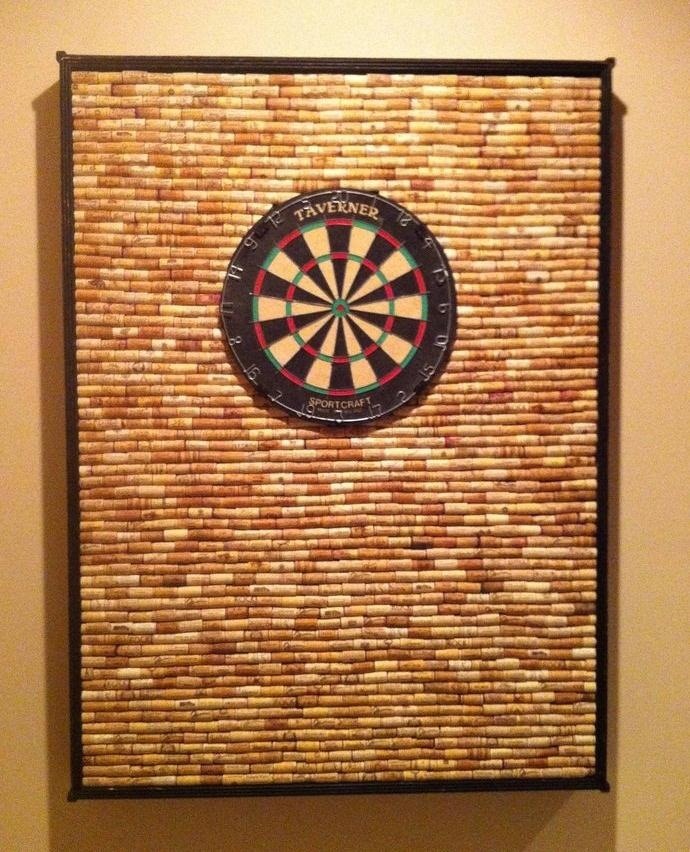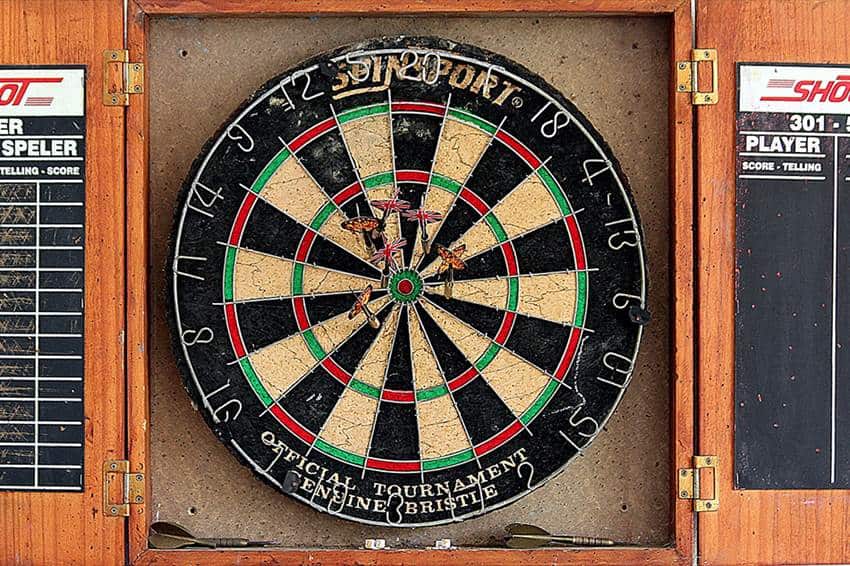To protect your wall when playing darts, use a dartboard backboard or surround made of durable material. Playing darts can be an exciting and engaging activity that requires focus and precision.
However, it can also lead to damage on your wall if not played carefully. The constant impact of sharp darts hitting the wall can leave unsightly holes and marks that are not easy to repair. That’s why it’s crucial to take precautionary measures to protect your wall when playing darts.
We will discuss some effective ways to safeguard your wall and keep it in pristine condition while enjoying a game of darts. By following these tips, you can enjoy your dart game without worrying about any wall damage. So let’s dive in and explore how to protect your wall when playing darts.

Credit: www.reddit.com
Understanding The Risks
Protecting your wall while playing darts is crucial to prevent damage and maintain its integrity. Understanding the risks involved and taking precautions like using a dartboard backer or adding protective coverings can help ensure your wall remains undamaged during dart games.
When playing darts, it’s important to not only focus on your aim and technique but also to consider the potential risks and damages that can occur to your wall. Without proper precautions, your wall could end up looking like a battlefield, covered in unsightly holes and damage. Understanding these risks is the first step towards protecting your wall and maintaining its pristine appearance.
Potential Damages
There are several potential damages that can occur when playing darts. These include:
Small holes and cracks
The impact of the darts hitting the wall can result in small holes and cracks, particularly if the darts are sharp-headed or thrown with excessive force.
Paint chipping
In addition to holes, the constant impact of darts hitting the wall can also cause the paint to chip, creating an unsightly and uneven surface.
Wallpaper damage
If your wall is adorned with wallpaper, this delicate covering can easily be torn or damaged by the sharp points of the darts. This can not only ruin the aesthetics of your wall but also lead to costly repairs.
Common Wall Materials At Risk
While all walls are susceptible to damages caused by darts, certain wall materials are more at risk than others. These include:
| Material | Risk Level |
|---|---|
| Drywall | High |
| Plaster | Moderate |
| Brick/Stone | Low |
| Wood | Low |
Drywall is particularly vulnerable due to its relatively soft composition, making it more prone to holes and cracks. Plaster walls, although sturdier, can still suffer damages from the impact of darts. On the other hand, brick/stone and wood walls tend to fare better, but they are not entirely immune to the risks posed by darts.
Now that you have a better understanding of the risks and potential damages involved in playing darts, it’s time to explore effective strategies for protecting your wall to ensure not only a safer environment but also a beautifully intact wall. Let’s dive into the measures you can take to safeguard your wall from dart-related mishaps.

Credit: macgyverisms.wonderhowto.com
How to Dart Proof Your Wall
Introducing effective ways to protect your wall from darts damage. Learn how to safeguard your wall while enjoying your dart games and minimize any potential wall repairs.
Protecting your wall when playing darts is essential to prevent unsightly and costly damages. The force of a dart hitting the wall can leave permanent marks or create holes that are difficult to repair. By taking a few simple measures, you can enjoy playing darts without worrying about damaging your wall.
Use A Wall Protector
Using a suitable wall protector is the first step in preventing wall damage when playing darts. A wall protector acts as a barrier between the dartboard and the wall, absorbing the impact and minimizing the risk of darts penetrating the wall surface. There are various options available, including:
Backboards
Attach a backboard to the wall behind the dartboard. Backboards are typically made of cork or similar materials that can absorb the dart’s impact.
Dartboard Cabinets
Opt for a dartboard cabinet, which not only protects your wall but also provides a stylish storage solution for your darts and accessories.
Dartboard Surrounds
Consider using a dartboard surround that wraps around the dartboard. Surrounds are made of foam or rubber materials that absorb the dart’s impact and protect both the wall and the dartboard surface.
Choose A Suitable Location
Selecting the right location for your dartboard is crucial in preventing wall damage. Here are a few tips to keep in mind:
Clearance
Ensure there is enough space around the dartboard to accommodate players and their movements. This minimizes the chances of accidental throws that could hit the wall.
Avoid Vulnerable Surfaces
Avoid placing the dartboard on delicate or easily damaged surfaces such as wallpaper, drywall without proper reinforcement, or fragile materials.
Consider Anchor Points
When choosing a location, look for areas with solid anchor points, such as studs or concrete walls, which can better withstand the force of a dart hitting the board.
Properly Hang The Dartboard
Properly hanging the dartboard is essential in preventing wall damage and ensuring a safe playing environment. Follow these steps to hang your dartboard securely:
Use a Measuring Tape
Measure the appropriate height and distance from the floor to the bullseye of the dartboard. This ensures proper alignment and prevents high throws that may damage the wall.
Find a Stud
Locate a wall stud using a stud finder or by tapping along the wall until you find a solid sound. Hanging the dartboard on a stud provides additional stability.
Use a Mounting Bracket
Attach a mounting bracket to the wall at the desired height, ensuring it aligns with the stud. Then, securely fasten the dartboard to the bracket using the appropriate screws or hardware.
Test the Stability
Give the dartboard a gentle shake to ensure it is securely mounted and does not wobble. Any looseness could result in increased vibrations and potential wall damage.
By following these tips to prevent wall damage, you can enjoy playing darts without the stress and expense of repairing your walls. Remember to always prioritize safety and choose the best wall protector and location for your dartboard.
Minimizing Bounce Outs
When playing darts, there is nothing more frustrating than a bounce out. Not only does it ruin your rhythm and break your concentration, but it can also damage your wall. To protect both your wall and your sanity, here are some key strategies to minimize bounce outs.
Optimal Dartboard Placement
Proper dartboard placement is crucial to prevent bounce outs. First, make sure the dartboard is mounted at the regulation height of 5 feet 8 inches from the floor to the center of the bullseye. This allows for a consistent throwing angle and optimal positioning for minimizing bounce outs.
Table 1: Optimal Dartboard Placement Guidelines
| Measurement | Distance |
|---|---|
| Height of Dartboard | 5 feet 8 inches |
| Distance from the floor to the bullseye | 68 inches |
Proper Dartboard Mounting
The way your dartboard is mounted on the wall can greatly affect the likelihood of bounce outs. When mounting the dartboard, ensure it is secured firmly and level. Use a proper dartboard bracket or mounting hardware to avoid any unwanted movements or vibrations that may cause bounce outs.
Table 2: Proper Dartboard Mounting Checklist
| Step | Description |
|---|---|
| 1 | Choose a suitable location on the wall. |
| 2 | Ensure the wall is sturdy and free from any obstructions. |
| 3 | Mount the dartboard using appropriate mounting hardware. |
| 4 | Make sure the dartboard is level to avoid any throwing inconsistencies. |
Improve Dart Throw Technique
Your dart throw technique plays a significant role in minimizing bounce outs. Focus on improving your aim and release to achieve more accurate throws. Here are some tips and tricks to enhance your dart throw technique:
- Stand at the optimum throwing distance, which is 7 feet 9 1/4 inches from the face of the dartboard.
- Maintain a steady and relaxed grip on the dart.
- Ensure a smooth and consistent follow-through after releasing the dart.
- Avoid overpowering your throw, as this can increase the chances of bounce outs.
- Practice regularly to develop muscle memory and improve your overall accuracy.
By following these guidelines for optimal dartboard placement, proper dartboard mounting, and improving your dart throw technique, you can significantly minimize bounce outs and enjoy a more satisfying game of darts while protecting your wall from any unnecessary damage.

Credit: darthelp.com
Wrapping Up
To wrap things up, it’s essential to prioritize the protection of your wall when indulging in a game of darts. By implementing these simple tips, such as mounting a dartboard backboard, using durable wall protectors, and maintaining proper distance, you can safeguard your walls effectively.
Remember, prevention is always better than the cure. With these precautions in place, you can enjoy your game without worrying about any potential damage to your walls. Happy darting!
FAQs
What Is The Best Material To Put Behind A Dart Board?
The best material to put behind a dartboard is a sturdy, high-density fiberboard or cork. These materials provide excellent durability and help to prevent bounce-outs.
What Darts Don’t Damage Walls?
Soft tip darts with plastic tips don’t damage walls. They are safe for indoor use and won’t cause any major dents or holes.
How Do You Set Up A Dart Board Without Damaging The Wall?
To set up a dart board without damaging the wall, follow these steps:
- Find a suitable location with enough space around the board.
- Use a wall protector or dartboard backboard to prevent damage to the wall.
- Hang the board securely using a bracket or mounting system.
- Ensure proper measuring and leveling for accurate installation.
- Use soft tip darts instead of steel tip to minimize the risk of wall damage.
Will Soft Tip Darts Damage Wall?
Soft tip darts typically do not damage walls due to their lightweight design and rubber tips. These darts are specifically made for indoor play and are safe to use on most surfaces. However, it’s always a good idea to protect your walls with a dartboard backboard or a suitable protective material to prevent any potential accidents.


